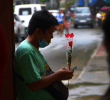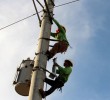MinDA through the Mindanao Power Monitoring Committee is looking into renewable energy sources or those that come from natural sources like the geothermal heat, rain, sunlight, tides, waves and wind.
By MARILOU AGUIRRE-TUBURAN
Davao Today
DAVAO CITY, Philippines – The Mindanao Development Authority (MinDA) is setting its sights in renewable energy and puts high premium in “safety nets.”
“We are focusing more on renewable energy sources and coal-fired power plants are not one of those,” said Reyzaldy Tan, MinDA’s Director for Policy, Planning and Project Development.
But he said MinDA is not closing its door in considering coal-fired power plants (CFPP) for as long as there are “safety nets” and that these will be “managed responsibly by the operators.” Safety nets, he said, will assure that the operations will not yield to the detrimental effect on the environment.
Yet for think tank Ibon Foundation and the government’s science and technology department, there is no compromise as far is coal is concerned.
“There has been a lot of hype that clean coal technologies have been developed,” said Sonny Africa, Research Head of think-tank Ibon Foundation, in a text to davaotoday.com.
Africa said that local scientist groups like Agham and environmental groups like Kalikasan have affirmed that coal remains one of the dirtiest sources of energy “polluting the air and water even if sometimes invisibly, and a leading contributor to global warming.”
For Doctor Anthony Sales, Director of the Department of Science and Technology-XI, “There is no denying that if we use coal there will be an impact on the environment.”
Sales said mining coal from the environment is one case. The operations would also affect surface (rivers and streams) and ground waters, including the aquifers.
“If you get huge amount of water on the daily basis, then we will have problems later on in the supply of drinking water,” he said.
“We need clean, renewable and affordable sources of energy and coal is none of these,” Africa noted.
Meanwhile, MinDA through the Mindanao Power Monitoring Committee is looking into renewable energy sources or those that come from natural sources like the geothermal heat, rain, sunlight, tides, waves and wind. One of the reasons is to address the deficit of power supply in the island, according to MinDA’s power focal person, Director Romeo Montenegro.
Last year, MinDA Chair Sec. Luwalhati Antonino said that Mindanao power crisis is just “artificial” following a series of power interruptions despite the existence of hydropower and geothermal plants and even diesel-powered barges in the island.
The current condition of Mindanao’s Agus-Pulangi Hydropower Plants (APHPs), which supplies 55 percent of the island’s power requirement, contributed to the said power deficit. APHPs’ installed capacity of 320 Megawatts (MW) was reduced to 100-150 MW due to siltation and degraded watersheds.
“Hydropower capacity can be maximized with quick rehabilitation,” MinDA’s Montenegro said.
The Electric Power Industry Reform Act (Epira) has something to do with the current state of the APHPs.
“There was a strong clamor among the stakeholders and even MinDA to review the Epira Law,” said Tan, citing the 2012 Energy Summit held in the city. The agency, he said, is opposing the proposed privatization of the APHPs.
The Epira Law deferred the privatization of APHPs in 10 years since it was enacted in 2001. In June 2011, the deferment has expired allowing government to invite bidders to take-over the said plants with three interested private corporations by the Sys, Aboitizes and Alcantaras.
“Our studies show that Napocor-Mindanao is earning. It can definitely subsidize the operations (of the APHPs),” Tan said.
Tan said they are developing some proposals for an indepth scientific-based study on how the extractive industries, like the large-scale mining and plantations, impact the environment and natural resources, in order to “come up with better position on large-scale mining, plantations and development projects.”
“By this study we will know if we are into this kind of development project or these will be for further review,” he said.
They will hold an Experts Forum this year under the Mindanao Nurturing our Waters program which will engage scientists and experts like geologists from Mindanao to help in the said study. They are also looking into international agencies like the International Alert which has an existing study on extractive industries and local agencies like the Mindanao Studies Consortium Foundation Incorporated. The study is expected to be completed this year.
“Responsible mining”
But while the study is not yet done, MinDA said “there must be responsible mining,” which will ensure that the country’s natural resources and environment must sustain their capacity for the benefit of the future generation.
Mines and Geosciences Bureau-XI Director Engr. Edilberto Arreza, told davaotoday.com in a text, that responsible mining is when companies operate in a sustainable way.
“It is when they can contribute so much to the country’s economy, and they will protect the environment and provide livelihood to the communities where they are operating,” he said.
“There will be no responsible mining with the current policy and program of the Aquino government,” Kalikasan-People’s Network for the Environment National Coordinator Clemente Bautista said. He added, “It only promotes destructive large-scale mining which have destroyed our forest and violated the rights of our people.” (Marilou Aguirre-Tuburan/davaotoday.com










